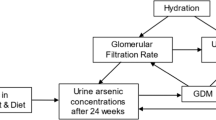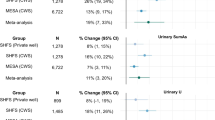Abstract
Exposure to inorganic arsenic (iAs) remains a global public health problem. Urinary arsenicals are the current gold-standard for estimating both iAs exposure and iAs metabolism. However, the distribution of these arsenicals may differ between the urine and target organs. Instead, plasma arsenicals may better represent internal dose and capture target organ exposure to arsenicals. Drinking water iAs, plasma and urinary arsenicals were quantified in individuals living in the Zimapan and Lagunera regions of Mexico. The relationship between drinking water iAs and plasma arsenicals was examined using both Spearman correlations and multivariable linear regression models. In addition, the distribution of arsenicals in plasma and urine was examined and the association between plasma and urinary arsenicals was assessed using both Spearman correlations and multivariable linear regression models. Levels of iAs in drinking water were significantly associated with plasma arsenicals in unadjusted and adjusted analyses and the strength of these associations was similar to that of drinking water iAs and urinary arsenicals. These results suggest that plasma arsenicals are reliable biomarkers of iAs exposure via drinking water. However, there were notable differences between the profiles of arsenicals in the plasma and the urine. Key differences between the proportions of arsenicals in plasma and urine may indicate that urine and plasma arsenicals reflect different aspects of iAs toxicokinetics, including metabolism and excretion.
This is a preview of subscription content, access via your institution
Access options
Subscribe to this journal
Receive 6 print issues and online access
$259.00 per year
only $43.17 per issue
Buy this article
- Purchase on Springer Link
- Instant access to full article PDF
Prices may be subject to local taxes which are calculated during checkout





Similar content being viewed by others
References
ATSDR. Substance priority list. 2017.
Naujokas MF, Anderson B, Ahsan H, Aposhian HV, Graziano JH, Thompson C, et al. The broad scope of health effects from chronic arsenic exposure: update on a worldwide public health problem. Environ Health Perspect. 2013;121:295–302.
Vahter M. Effects of arsenic on maternal and fetal health. Annu Rev Nutr. 2009;29:381–99.
Hughes MF. Biomarkers of exposure: a case study with inorganic arsenic. Environ Health Perspect. 2006;114:1790–6.
Kuo CC, Moon KA, Wang SL, Silbergeld E, Navas-Acien A. The association of arsenic metabolism with cancer, cardiovascular disease, and diabetes: a systematic review of the epidemiological evidence. Environ Health Perspect. 2017;125:087001.
Gamboa-Loira B, Cebrian ME, Franco-Marina F, Lopez-Carrillo L. Arsenic metabolism and cancer risk: a meta-analysis. Environ Res. 2017;156:551–8.
Del Razo LM, Garcia-Vargas GG, Valenzuela OL, Castellanos EH, Sanchez-Pena LC, Currier JM, et al. Exposure to arsenic in drinking water is associated with increased prevalence of diabetes: a cross-sectional study in the Zimapan and Lagunera regions in Mexico. Environ Health: a Glob Access Sci Source. 2011;10:73.
Currier JM, Ishida MC, Gonzalez-Horta C, Sanchez-Ramirez B, Ballinas-Casarrubias L, Gutierrez-Torres DS, et al. Associations between arsenic species in exfoliated urothelial cells and prevalence of diabetes among residents of Chihuahua, Mexico. Environ Health Perspect. 2014;122:1088–94.
Grau-Perez M, Kuo CC, Spratlen M, Thayer KA, Mendez MA, Hamman RF, et al. The association of arsenic exposure and metabolism with type 1 and type 2 diabetes in youth: the SEARCH Case-Control study. Diabetes Care. 2017;40:46–53.
Mandal BK, Suzuki KT, Anzai K. Impact of arsenic in foodstuffs on the people living in the arsenic-affected areas of West Bengal, India. J Environ Sci Health Part A, Toxic/Hazard Subst & Environ Eng. 2007;42:1741–52.
Drobna Z, Del Razo LM, Garcia-Vargas GG, Sanchez-Pena LC, Barrera-Hernandez A, Styblo M, et al. Environmental exposure to arsenic, AS3MT polymorphism and prevalence of diabetes in Mexico. J Expo Sci Environ Epidemiol. 2013;23:151–5.
Del Razo LM, Arellano MA, Cebrian ME. The oxidation states of arsenic in well-water from a chronic arsenicism area of northern Mexico. Environ Pollut (Barking, Essex: 1987). 1990;64:143–53.
Armienta M, Rodríguez C. Evaluación de la presencia de Arsénico en el valle de Zimapan Hidalgo. Universidad Nacional Autónoma de México, 1993:33–43.
Del Razo LM, Garcia-Vargas GG, Garcia-Salcedo J, Sanmiguel MF, Rivera M, Hernandez MC, et al. Arsenic levels in cooked food and assessment of adult dietary intake of arsenic in the Region Lagunera, Mexico. Food Chem Toxicol: Int J Publ Br Ind Biol Res Assoc. 2002;40:1423–31.
SARH (Secretaría de Agricultura y Recursos Hidraúlicas) Estudio de Hidroarsenicismo en la Comarca Lagunera, México. Cinvestav-IPN, Comisión de Aguas del Valle de México de SARH, 1989.
Devesa V, Maria Del Razo L, Adair B, Drobna Z, Waters SB, Hughes MF, et al. Comprehensive analysis of arsenic metabolites by pH-specific hydride generation atomic absorption spectrometry. J Anal At Spectrom. 2004;19:1460–7.
Le XC, Ma M. Short-column liquid chromatography with hydride generation atomic fluorescence detection for the speciation of arsenic. Anal Chem. 1998;70:1926–33.
Hernandez-Zavala A, Matousek T, Drobna Z, Paul DS, Walton F, Adair BM, et al. Speciation analysis of arsenic in biological matrices by automated hydride generation-cryotrapping-atomic absorption spectrometry with multiple microflame quartz tube atomizer (multiatomizer). J Anal Spectrom. 2008;23:342–51.
Matoušek T, Currier JM, Trojánková N, Saunders RJ, Ishida MC, González-Horta C, et al. Selective hydride generation- cryotrapping- ICP-MS for arsenic speciation analysis at picogram levels: analysis of river and sea water reference materials and human bladder epithelial cells. J Anal At Spectrom. 2013;28:1456–65.
WHO. Physical status: the use and interpretation of anthropometry. Geneva: World Health Organization; 1995.
Agusa T, Fujihara J, Takeshita H, Iwata H. Individual variations in inorganic arsenic metabolism associated with AS3MT genetic polymorphisms. Int J Mol Sci. 2011;12:2351–82.
Drobna Z, Walton FS, Paul DS, Xing W, Thomas DJ, Styblo M. Metabolism of arsenic in human liver: the role of membrane transporters. Arch Toxicol. 2010;84:3–16.
Healy SM, Casarez EA, Ayala-Fierro F, Aposhian H. Enzymatic methylation of arsenic compounds. V. Arsenite methyltransferase activity in tissues of mice. Toxicol Appl Pharmacol. 1998;148:65–70.
Jiang X, McDermott JR, Ajees AA, Rosen BP, Liu Z. Trivalent arsenicals and glucose use different translocation pathways in mammalian GLUT1. Metallomics. 2010;2:211–9.
Liu Z, Boles E, Rosen BP. Arsenic trioxide uptake by hexose permeases in Saccharomyces cerevisiae. J Biol Chem. 2004;279:17312–8.
Shen H, Niu Q, Xu M, Rui D, Xu S, Feng G, et al. Factors affecting arsenic methylation in arsenic-exposed humans: a systematic review and meta-analysis. Int J Environ Res Public Health. 2016;13:205.
Lindberg AL, Ekstrom EC, Nermell B, Rahman M, Lonnerdal B, Persson LA, et al. Gender and age differences in the metabolism of inorganic arsenic in a highly exposed population in Bangladesh. Environ Res. 2008;106:110–20.
Gamble MV, Liu X, Ahsan H, Pilsner R, Ilievski V, Slavkovich V, et al. Folate, homocysteine, and arsenic metabolism in arsenic-exposed individuals in Bangladesh. Environ Health Perspect. 2005;113:1683–8.
Hall MN, Gamble MV. Nutritional manipulation of one-carbon metabolism: effects on arsenic methylation and toxicity. J Toxicol. 2012;2012:595307.
Jones MR, Tellez-Plaza M, Vaidya D, Grau M, Francesconi KA, Goessler W, et al. Estimation of inorganic arsenic exposure in populations with frequent seafood intake: evidence from MESA and NHANES. Am J Epidemiol. 2016;184:590–602.
Peters BA, Hall MN, Liu X, Neugut YD, Pilsner JR, Levy D, et al. Creatinine, arsenic metabolism, and renal function in an arsenic-exposed population in Bangladesh. PLoS One. 2014;9:e113760.
Peters BA, Hall MN, Liu X, Slavkovich V, Ilievski V, Alam S, et al. Renal function is associated with indicators of arsenic methylation capacity in Bangladeshi adults. Environ Res. 2015;143(Pt A):123–30.
Acknowledgements
Funding for this work was provided by the National Institute of Environmental Health Sciences (T32-ES007018 and 5R01-ES015326-02) and the Gillings Innovation Laboratory.
Author information
Authors and Affiliations
Corresponding authors
Ethics declarations
Conflict of interest
The authors declare that they have no conflict of interest.
Additional information
Publisher’s note: Springer Nature remains neutral with regard to jurisdictional claims in published maps and institutional affiliations.
Supplementary Information
Rights and permissions
About this article
Cite this article
Bommarito, P.A., Beck, R., Douillet, C. et al. Evaluation of plasma arsenicals as potential biomarkers of exposure to inorganic arsenic. J Expo Sci Environ Epidemiol 29, 718–729 (2019). https://doi.org/10.1038/s41370-019-0121-x
Received:
Revised:
Accepted:
Published:
Issue Date:
DOI: https://doi.org/10.1038/s41370-019-0121-x
Keywords
This article is cited by
-
Heavy metal association with chronic kidney disease of unknown cause in central India-results from a case-control study
BMC Nephrology (2024)
-
Association Between Arsenic Toxicity, AS3MT Gene Polymorphism and Onset of Type 2 Diabetes
Biological Trace Element Research (2024)



